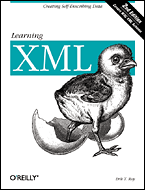| |  | Copyright |
| |  | Foreword |
| |  | Preface |
| | |  | What's Inside |
| | |  | Style Conventions |
| | |  | Examples |
| | |  | Comments and Questions |
| | |  | Acknowledgments |
 |
| |  | Chapter 1. Introduction |
| | |  | Section 1.1. What Is XML? |
| | |  | Section 1.2. Where Did XML Come From? |
| | |  | Section 1.3. What Can I Do with XML? |
| | |  | Section 1.4. How Do I Get Started? |
 |
| |  | Chapter 2. Markup and Core Concepts |
| | |  | Section 2.1. Tags |
| | |  | Section 2.2. Documents |
| | |  | Section 2.3. The Document Prolog |
| | |  | Section 2.4. Elements |
| | |  | Section 2.5. Entities |
| | |  | Section 2.6. Miscellaneous Markup |
 |
| |  | Chapter 3. Modeling Information |
| | |  | Section 3.1. Simple Data Storage |
| | |  | Section 3.2. Narrative Documents |
| | |  | Section 3.3. Complex Data |
| | |  | Section 3.4. Documents Describing Documents |
 |
| |  | Chapter 4. Quality Control with Schemas |
| | |  | Section 4.1. Basic Concepts |
| | |  | Section 4.2. DTDs |
| | |  | Section 4.3. W3C XML Schema |
| | |  | Section 4.4. RELAX NG |
| | |  | Section 4.5. Schematron |
| | |  | Section 4.6. Schemas Compared |
 |
| |  | Chapter 5. Presentation Part I: CSS |
| | |  | Section 5.1. Stylesheets |
| | |  | Section 5.2. CSS Basics |
| | |  | Section 5.3. Rule Matching |
| | |  | Section 5.4. Properties |
| | |  | Section 5.5. Examples |
 |
| |  | Chapter 6. XPath and XPointer |
| | |  | Section 6.1. Nodes and Trees |
| | |  | Section 6.2. Finding Nodes |
| | |  | Section 6.3. XPath Expressions |
| | |  | Section 6.4. XPointer |
 |
| |  | Chapter 7. Transformation with XSLT |
| | |  | Section 7.1. History |
| | |  | Section 7.2. Concepts |
| | |  | Section 7.3. Running Transformations |
| | |  | Section 7.4. The stylesheet Element |
| | |  | Section 7.5. Templates |
| | |  | Section 7.6. Formatting |
 |
| |  | Chapter 8. Presentation Part II: XSL-FO |
| | |  | Section 8.1. How It Works |
| | |  | Section 8.2. A Quick Example |
| | |  | Section 8.3. The Area Model |
| | |  | Section 8.4. Formatting Objects |
| | |  | Section 8.5. An Example: TEI |
| | |  | Section 8.6. A Bigger Example: DocBook |
 |
| |  | Chapter 9. Internationalization |
| | |  | Section 9.1. Character Encodings |
| | |  | Section 9.2. MIME and Media Types |
| | |  | Section 9.3. Specifying Human Languages |
 |
| |  | Chapter 10. Programming |
| | |  | Section 10.1. Limitations |
| | |  | Section 10.2. Streams and Events |
| | |  | Section 10.3. Trees and Objects |
| | |  | Section 10.4. Pull Parsing |
| | |  | Section 10.5. Standard APIs |
| | |  | Section 10.6. Choosing a Parser |
| | |  | Section 10.7. PYX |
| | |  | Section 10.8. SAX |
| | |  | Section 10.9. DOM |
| | |  | Section 10.10. Other Options |
 |
| |  | Appendix A. Resources |
| | |  | Section A.1. Online |
| | |  | Section A.2. Books |
| | |  | Section A.3. Standards Organizations |
| | |  | Section A.4. Tools |
| | |  | Section A.5. Miscellaneous |
 |
| |  | Appendix B. A Taxonomy of Standards |
| | |  | Section B.1. Markup and Structure |
| | |  | Section B.2. Linking |
| | |  | Section B.3. Addressing and Querying |
| | |  | Section B.4. Style and Transformation |
| | |  | Section B.5. Programming |
| | |  | Section B.6. Publishing |
| | |  | Section B.7. Hypertext |
| | |  | Section B.8. Descriptive/Procedural |
| | |  | Section B.9. Multimedia |
| | |  | Section B.10. Science |
 |
| |  | Glossary |
| | |  | A |
| | |  | B |
| | |  | C |
| | |  | D |
| | |  | E |
| | |  | F |
| | |  | H |
| | |  | I |
| | |  | L |
| | |  | M |
| | |  | N |
| | |  | O |
| | |  | P |
| | |  | Q |
| | |  | R |
| | |  | S |
| | |  | T |
| | |  | U |
| | |  | W |
| | |  | X |
 |
| |  | Colophon |
| |  | Index |
